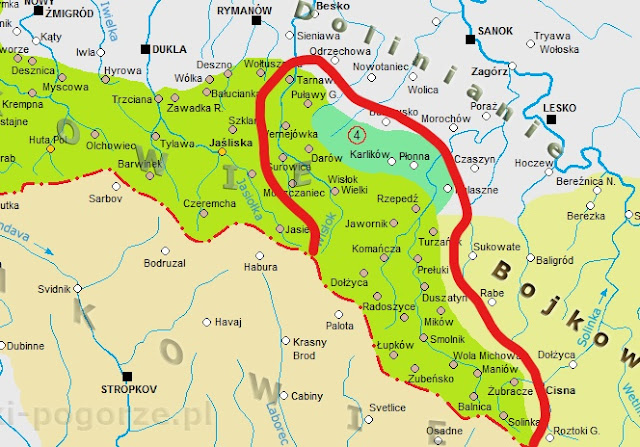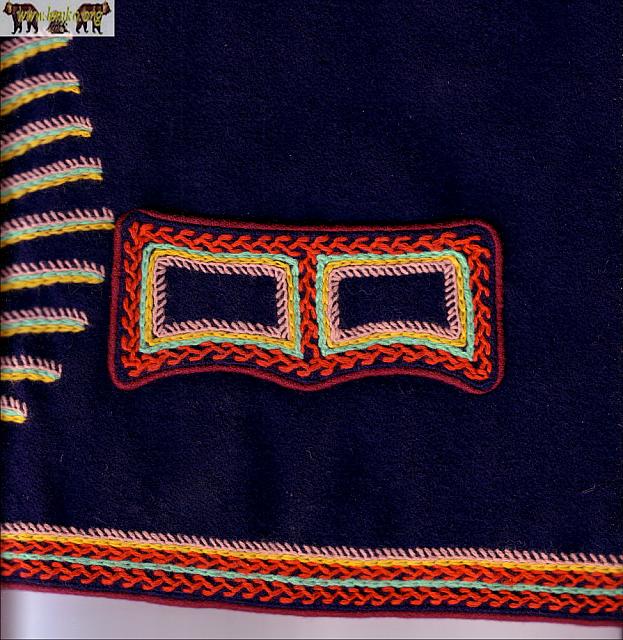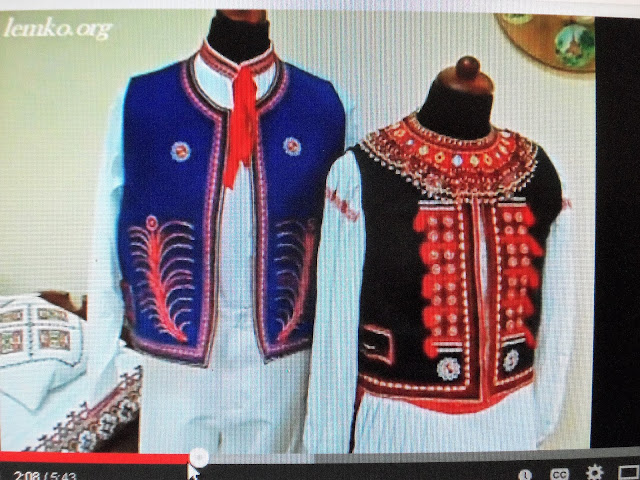Hello all,
I have already written an article about this costume, but I have learned much since that time, and so I will write a more complete article now.
The Eastern Lemko region consists of the valleys of the Wislok and Oslava rivers. Both are tributaries of the Sian or San river. The Boiko region begins east of that point. Here is a map of this area.
Some maps mistakenly show the Lemko region extending further east, even to the current border of Ukraine.
Although this region is rather small, the folk costume is well known, because the costume of the village of Komancha is well attested, and has often been replicated. This is in part due to the work of Kul'chytska, some of whose art depicts this costume. You can see Komancha in the center of this region above. The following images are from Komancha or of unkown origin unless specified otherwise.
The basal garment is the chemise, which started as one long garment.The cut most associated with this region is the 'non-inset' cut, in which the top of the sleeve is gathered into the neckband.
At the point where the upper sleeve becomes narrower, there is traditionally a narrow band of embroidery, at the point where a shoulder seam would have been. This embroidery was about an inch wide, and was usually of red and blue cross stitch. Here are some examples.
Here is another example which i put into a sampler.
Sometimes you will see them graphed with black instead of blue. This is a result of not having colored inks available.
Here are some old examples from museums. These illustrate what I consider to be a shockingly bad practice, cutting the embroidery off garments and disposing of the rest.
Later, yellow and other colors were added, perhaps under the influence of Boiko embroidery.
This example is from the village of Radoshytsi - Радошиці, Radoszyce in Polish.
In this example, the gathering is held with bought jacquard ribbon, and the edge is deecorated with rows of merezhuvannia.
Later the band of embroidery was sometimes made wider, perhaps under the influence of Boiko or other Ukrainian embroidery found further east.
The skirts greatly resembled those of the Central Lemko region, being ornamented with ribbons and even more finely pleated. There was perhaps a tendency to use brighter colors, especially by younger women and girls. Unlike the Central Lemko aprons, rows of bought lace were often used. If you look at the painting from Kul'chytska above, she shows the skirts being white linen.
This girl is from Komancha.
The aprons were also in brighter colors, yellow being common. They were finely pleated, and often had a gathered flounce on the lower edge. They were sometimes made from printed cotton which was intended for kerchiefs. They were several inches shorter than Central Lemko aprons, the skirt showing below them.
These girls are from the village of Chystohorb.
A kraika, or sash, was not worn with this costume, but sometimes they would hang a length of decorative ribbon to look like one. However this should be hung in the middle back.
The women's detached bodice, or vest, called leibek or laibek uses a similar cut as the men's vest from Central Lemkovyna.
There are two tails in the center back, and the edges, fake pockets, and especially the front edges are elaborated with chain stitch and other embroidery, and sometimes buttons. There is some variation in the embroidery, but the overall composition tends to be similar.The small details in the corners and center back vary.
This is a beautiful vest displayed with a shirt which simply does not go with it.
This vest is from the village of Dowzhytsia - Довжиця, Dołżyca in Polish, about 4 miles southwest of Komancha.
Here is Kul'chytska's sketch of the embroidery on the shirt and vest.
On the other hand, folk costumes were never uniforms. Here are two photos showing a very different vest, although the rest of the costume matches. The first one is from Komancha.
This one is from the village of Radoshytsi - Радошиці - Radoszyce.
Sometimes women wore the same sort of necklace and ribbon as they do in Central Lemkovyna. Here is a girl from Komancha.
But what is most typical for Komancha and the Oslava valley is a beaded collar, called by Lemkos kryvul'ka, but in Ukrainian sources often Sylianka or Kryza. If you scan the various images, most will be wearing the kryvul'ka or nothing.
This is an incredible example of folk art, and has become symbolic of the Lemko people, but was only worn in the Oslava valley from about Shchawne south.
Here are more examples.
Here is a couple from the village of Chystohorb - Чистогорб, Czystogarb in Polish. The skirt is short and she is wearing a contemporary blouse, but the rest of the costume is the same.
People went barefoot, or wore moccasins with footcloths, later replaced by knitted stockings. Boots were worn by those who could afford them, and later leather shoes were also worn with this outfit.
Unmarried girls wore their hair in a single braid with ribbons attached, and tied kerchiefs over their head in cold weather.
If you look closely at some of the old photographs, you can see that they tied a white kerchief into a sort of loose hood and used it as protection from the sun.
Both commercial printed kerchiefs and linen ones with embroidery were used. They were called fatselyk.
This kerchief is from the village of Smil'nyk - Смільник - Smolnik.
As is the rest of this outfit.
Married women traditionally wore a chepets' over their hair. Kul'chytska shows the edge of it under the kerchief and it is visible in the image at the head of this article, but in many old photos there is no visible sign of it. Here is one exception from the village of Solynka - Солинка, Solinka in Polish. She is in everyday dress, but has the chepets' on, as well as the traditional skirt and apron. It seems to have disappeared early from Komancha.
Here is a museum example of an original chepets' from this region.
Here is a reproduction on a model.
As in other Lemko / Rusyn areas, the hair would be wrapped around a khymlia, a ring of wood or wire which was wrapped in cloth, and then the chepets' would be worn over this. From the shape of this chepets', it would have been worn on the upper back of the head.
There are old wedding rituals that centered on the capping of the bride. Here is one famous photograph of a wedding in Komancha. The bride and groom are looking at each other not through a ring of bread, but a khymlia which has been wrapped in many layers of yarn for this ceremony. Unusually, the bride in this region wears her hair loose until it is time to put on the chepets'.
Here is another shot of the bride and groom.
The men's costume differs little from that of the Central Lemkos.
The shirt is full, with sleeves gathered into cuffs. If you look at the master of ceremonies from the wedding photo just above, there is no embroidery.
Here is a man from Komancha shearing a sheep.
In later periods, however, men wanted embroidery on their shirts.
The pants were linen in summer, over which heavy wool pants were worn in winter. Again, similar to those of the Gorals or other Lemkos. They had one or two openings in front, a casing at the waist for a belt or drawstring, and minimal ornamentation.
This man is from the village of Wysochane in the northern part of the Eastern Lemko Region. He is wearing boots, which is unusual. Look also at the photos from the wedding above, and you can see a colored cord or ribbon on the sides of the pants.
You will sometimes see men wearing a vest similar to the women, as in the photo at the head of this article, but historical images do not show this. They either show a plain vest, as in the man above, and this one of a man from the village of Smolnyk,
or a vest which is cut in the same manner, but with very different embroidery. Take a look at this photo from Zubriache - Зубряче, Żubracze in Polish.
The boy is wearing a plain vest, but the man's is embroidered.
If you look at the corner of Kul'chytska's painting, you will see a man wearing a vest with similar fern leaf embroidery.
Here is a cross-dressing woman who is wearing a man's vest from this region. [Really, we men have little enough without women stealing our clothes!]
Here are closeups of a couple of such vests.
And a couple of images of the whole outfit.
Ok, this one is excessively exaggerated.
Here is what looks like the same guy modeling three different vests, each of which is slightly different. Note that some have buttons.
The short jacket hunia is also worn in this region, by both women and men.
This woman is from the village of Daliova, which is actually just over the line in the eastern part of Central Lemkovyna.
This man is from the village of Smolnyk.
This woman is from the village of Yavirnyk - Явірник - Jawornik. She is wearing a sheepskin coat called kozhukh.
The chuhania of the Eastern Lemkos resembles that worn in the eastern part of Central Lemkovyna, with the large round collar in front, but the pale stripe on the back of the collar has some ornamentation in brown yarn.
The village of Smolnyk again.
A groom or groomsman from the village of Wysochane in the northern part of this region.
Here are some more images of this costume.
Later, the Polish style gorset was also worn in this region.
There are two subregions in the northern part of Eastern Lemkovyna, each with a distinct costume. I do not have enough material to do them justice, so I will present the little that I have here, in the hope that one of my readers will be able to add to it.
Wislok valley.This is in the northwest part of this region.
The village of Moshchanets' - Мощанець, Moszczaniec in Polish.
A fascinating costume. Embroidery on both their shirts.
This may possibly be from the same village.
The village of Vyslik Velykyj - Вислік Великий, Wislok Wielki in Polish.
The following images are labeled as from this village, but resemble those of the next subregion.
Lemko-Boiko transitional region.
Reinfuss separated this as a distinct region, even though it is small. It is shown in a different shade of green on the map, marked here with a 4. It includes the villages of 1 Kuliashne - Куляшне - Kulaszne, 2 Vysochany - Височани - Wysoczany, 3 Polonna - Полонна - Płonna, 4 Karlykiw - Карликів - Karlików, 5 Prybyshiw - Прибишів - Przybyszów, 6 Kamianne - Кам'яне - Kamienne, 7 Petrova Volia - Воля Петрова - Wola Piotrowa, and 8 Tokarnia - Токарня - Tokarnia.
Karlykiw
Kuliashne
Kozhushne, now a part of the neighboring village Vysochane.
Делегація лемків на з'їзді гуралів (гірських народів) 1934, Краків.
Lemko delegation to the conference of the Gorals (Highlanders) 1934, Krakow
You can see people from both the Komancha region and the northern region participating.
And that is plenty for one article. A definite improvement over my first one.
Thank you for reading. I hope that you have found this to be interesting and informative.
Roman K.
As in the last article I have relied heavily on the research done by William Vasyl Jula for this writing.
email: rkozakand@aol.com
Source Material:
Bohdan Struminsy, Editor, 'Lemkiwshchyna -The Lemko Land' New York, 1988
Tamara Nikolajeva, 'Ukrajinskyj Kostium, Nadija na Renesans' Kyjiw [Kiev], 2005
Iryna Hurhula, 'Narodne Mystetstvo Zakhidnykh Oblastej Ukrajiny', Kyjiw [Kiev], 1966
Oksana Grabowycz, 'Traditional Designs in Ukrainian Textiles', New York, 1977
Stanislaw Gadomski, 'Stroj Ludowy w Polsce', Warsaw,
Oksana Kosmina, 'Traditional Ukrainian Clothing', Kyjiw [Kiev], 2007
V. Kubijovyc, 'Lemkos', article in Encyclopedia of Ukraine, Toronto, 1993
V. Bilozub et al, 'Ukrajins'ke Narodne Mystetstvo - Vbrannia', Kyjiw [Kiev], 1961
Peter Odarchenko et al, 'Ukainian Folk Costume', Toronto, 1992
Ewa Frys et al, 'Folk Art in Poland', Warsaw, 1988
M. Bilan, H. Stel'mashchuk, 'Ukrajinskyj Strij', L'viw, 2000
O. Kul'chytska, 'Folk Costumes of the Western Regions of the Ukrainian SSR, 1959




























































































































































































